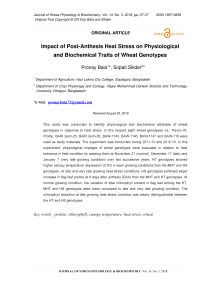Impact of post-anthesis heat stress on physiological and biochemical traits of wheat genotypes
Автор: Bala Pronay, Sikder Sripati
Журнал: Журнал стресс-физиологии и биохимии @jspb
Статья в выпуске: 3 т.14, 2018 года.
Бесплатный доступ
This study was conducted to identify physiological and biochemical attributes of wheat genotypes in response to heat stress. In this respect eight wheat genotypes viz., Pavon-76, Prodip, BARI Gom-25, BARI Gom-26, BAW-1143, BAW-1146, BAW-1147 and BAW-118 were used as study materials. The experiment was conducted during 2011-12 and 2012-13. In this experiment, physiological changes of wheat genotypes were evaluated in relation to heat tolerance in field condition by seeding them at November 27 (normal), December 17 (late) and January 7 (very late growing condition) over two successive years. HT genotypes showed higher canopy temperature depression (CTD) in each growing conditions than the MHT and HS genotypes. At late and very late growing heat stress conditions, HS genotypes exhibited larger increase in flag leaf proline at 8 days after anthesis (DAA) than the MHT and HT genotypes. At normal growing condition, the variation of total chlorophyll content in flag leaf among the HT, MHT and HS genotypes were lower compared to late and very late growing condition. The chlorophyll reduction at late growing heat stress condition was clearly distinguishable between the HT and HS genotypes.
Proline, chlorophyll, canopy temperature, heat stress, wheat
Короткий адрес: https://sciup.org/143166690
IDR: 143166690
Текст научной статьи Impact of post-anthesis heat stress on physiological and biochemical traits of wheat genotypes
Wheat is the second main source of world's energy and nutrition. Wheat provides 21% of food calories and 20% of protein for more than 4.5 billion people worldwide (Barun et al. 2010). Wheat grain is a staple food has special gluten proteins that made it possible to make flour, breads, biscuits, cookies, cakes, pasta, noodles and also for beer, other alcoholic beverages or biofuel (Shewry 2009). It is grown on about 218.5 million hectare in a range of environments, with annual production of about 712.31 metric tons (FAO 2014). Continual heat stress (mean daily temperature of over 17.5º C in the coolest month of the season) affects approximately 7 million hectares of wheat in developing countries, while terminal heat stress is a problem in 40% of temperate environments, which cover 36 million hectares (Reynolds et al. 2010). It has thus posed a severe threat to wheat production in many countries, particularly when it occurs during reproductive and grain filling phases. Unlike drought and salinity stresses, changes in ambient temperatures occur within hours. Therefore, plants need to suppress and respond to the adverse. For healthy wheat growth and a good yield, the range of the optimum temperatures was 18 to 24°C. Temperatures above 28 to 32°C for short periods (e.g.,5 to 6 days) found to cause about 20% or more wheat yield losses ( Stone and Nicolas 1994). This is because heat stress causes an array of physiological, biochemical and morphological changes in wheat which reduce tillering capacity, shortens grain filling period and accelerates crop senescence (Elbashier et al . 2012).It further reduces the plant’s photosynthetic capacity through metabolic limitation and oxidative damage to chloroplasts with concomitant reduction in dry matter accumulation and yield (Farooq et al. 2011). The effect of heat stress on wheat production is likely to worsen with the advent of climate change (Reynolds et al . 2010). The objective of this study was to asses the discriminating ability to physiological screening tests applied to wheat subjected to heat stress and to evaluate their relative utility as predictor to stress tolerance..
MATERIALS AND METHODS
The experiment was carried out at the research farm of Crop Physiology and Ecology Department, HSTU, Dinajpur during 2011-12 and 2012-13 and laid out in a split plot design with three replications. The unit plot size was 3m × 2m and management practice for crop production recommended by WRC was followed. There were three sowing time (normal, late and very late) and eight genotypes {Prodip, BARI Gom-25, BARI Gom-26, BAW-1143, BAW-1146, BAW-1147, BAW-1148 and Pavon-76 (as check)}.
The treatment factors A and B was-
-
A. Main plot treatment: Three growing conditions
-
1. Normal sowing condition (Sowing at 27 November)
-
2. Late sowing or post- anthesis heat stress condition (Sowing at 17 December)
-
3. Very late sowing or extreme post-anthesis heat stress condition (Sowing at 07 January for 2011-12 and 2012-13)
-
-
B. Sub plot treatment : Eight wheat genotypes viz. Prodip, BARI Gom-25, BARI Gom-26, BAW-1143, BAW-1146, BAW-1147, BAW-1148 and Pavon-76 (as check). The following traits were measured.
-
(a) Flag leaf chlorophyll
-
(b) Flag leaf proline
-
(c) Canopy temperature depression (CTD).
Chlorophyll estimation
Total chlorophyll content of flag leaves measured at heading, anthesis, 10days after anthesis (DAA) and 20 DAA respectively. The leaves material was processed in the fresh state immediately after collection. After fine chopping portions, weighing 0.5 g was measured by an electrical balance. The measured material was then homogenized in coloured bottle with the addition of 20 ml of 80% acetone. Then it was placed in dark place for 48 hrs with tied aluminium foil. The extract product in this way was subjected to reading on a spectrophotometer (Model: SPECTRO UV-VIS RS, Labomed Inc, USA) and chlorophyll content was calculated according to Witham et al. (1986) using the following formulae:
Total (a+b) chlorophyll (mg/g FW) = [20.2(D645 + 8.02(D663)] × [v/ (1000 ×w)]
Where, D=optical density, v=Volume of the extract in ml, w= Fresh weight of sample in g, 663 and 645 are wave lengths in nm.
Estimation of proline
Proline contents of the flag leaf at 8 DAA in all the wheat genotypes grown in two different growing conditions were estimated. At 8 DAA, the flag leaves from each replication of each genotype were collected and immediately kept in the ice-bag and were brought to Crop Physiology Laboratory of HSTU for proline estimation. One gram fresh weight of the flag leaf was taken for proline estimation. Subsequently proline was estimated as Troll and Lindsley (1955).
At first ninhydrin reagent was prepared in such a way so that it was utilized for proline estimation within two hours of preparation. For preparing ninhydrin reagent, addition of 30 ml glacial acetic acid and 30 ml 6M orthophosphoric acid were mixed with 1.25 g of ninhydrin. It was subsequently heated and stirred gently to dissolve but the temperature was not allowed to exceed 700C. Proline standards were prepared for 0, 2, 4, 6, 8, 10, 12, 14, 16, 18, and 20 ppm with distilled water.
The fresh samples were crushed in mortar and pestle and homogenized the material in 10 ml 3% sulphosalicylic acid until no large segments of plant material remained. Homogenate was filtered through Whatman No. 2 filter paper and washed with 3% sulphosalicylic acid and the volume was set to 25 ml. Two ml of the filtrate and each standard proline solutions were then reacted with 2 ml of ninhydrin reagent and 2 ml of glacial acetic acid in a pyrex test tube and boiled for one hour at 1000C in water bath covering the tube with aluminium foil to prevent excess evaporation. Subsequently, it was cooled in ice bath and 4 ml of toluene was added to each tube using a dispensor. Each tube was then shaken vigorously for 15 to 20 seconds in an electrical shaker and allowed the layer to separate for 30 minutes. The absorbance of layer was measured through spectrophotometer at 520 nm with pure toluene as a blank. Proline content was expressed on a fresh weight basis from the standard curve, using standard L-proline according to the method developed by to Troll and Lindsley (1955)and calculated on fresh weight basis as follows:
µmoles proline/g of fresh weight material = [(µg proline/ml×4ml toluene)/115.5 µg/µmole]/[(0.5g sample/5]
Canopy temperature depression (CTD)
A hand held infra-red thermometer (Model: Crop TRAK Item no. 2955L – Spectrum Technologies, Inc.) was used to measure this trait i.e. the difference between ambient air temperature and canopy temperature in degree centigrade. The reading was taken each plot by keeping it in hand 0.5 m above the plants at an angle of 45° to the horizontal. The CTD was recorded at 5 days after anthesis during noon period under bright sunlight and less wind. Air temperature was also measured for computation of canopy temperature depression (CTD) measurements. CTD was calculated using the formula:
CTD =Air temperature - Canopy temperature.Statistical analysis
The data were analyzed by partitioning the total variance with the help of computer by using MSTAT-C computer package (Russell, 1994). The treatment means were compared using Duncan’s Multiple Range Test (DMRT) (Duncan, 1955) at P≤0.05. Correlation and Regression analysis was also done and level of significance was tested with t-test (Singh and Choudhary, 1985).
RESULTS
Flag leaf chlorophyll
The effect of growing conditions on total chlorophyll of flag leaf of eight wheat genotypes at heading, anthesis, 10 days after anthesis and 20 days after anthesis (DAA) is presented in Figures 1.1 and 1.2 for first year (2011-12) and the second year (2012-13), respectively. Results showed that the combined effect of sowing times and genotypes on total chlorophyll at heading and different DAA such as 10 and 20 DAA was different. The total chlorophyll content of flag leaf was slightly increased in all the genotypes from heading to anthesis. But after anthesis the chlorophyll content was found to be decreased and finally, reached to the lowest level at 20 DAA in both the HT (BAW-1143, BARI Gom-25,BARI Gom-26 and Prodip), MHT(BAW-1146,BAW-
1147,BAW-1148 ) and HS (Pavon-76) genotypes for each growing condition of each year. All the genotypes reached their highest level of total chlorophyll content at the time of anthesis and thereafter slowly decreased.
Under normal growing condition up to 10 DAA, heat tolerant and heat sensitive genotypes did not show any noticeable variation in the quantity of decrease in flag leaf chlorophyll though heat sensitive genotype (Pavon-76) and MHT genotypes (BAW-1146, BAW-1147 and BAW-1148) had comparatively lower quantity of chlorophyll. At 20 DAA, the HS genotype (Pavon-76) and MHT genotypes (BAW-1146, BAW-1147 and BAW-1148) were found to retain much lower quantity of chlorophyll compared to heat tolerant genotypes. In this growing condition at 20DAA, all the genotypes contained about 2 mg/g FW total chlorophyll at 20 DAA. However, under late and very late growing condition, the flag leaf chlorophyll level was found to differ widely between the HT and HS genotypes from heading to senescence and in reduced form.
Proline content
Results showed that the flag leaf proline of different wheat genotypes at 8 DAA was significantly influenced by the combined effect of growing conditions and genotypes and it is presented in Tables 1.1 and 1.2 for first and second year, respectively. Under normal growing condition, proline content in the flag leaf was significantly higher in genotype BAW-1143 (3.87 and 3.76 m mole/g fresh wt. for the first year and the second year respectively), BARI Gom-26 (3.65 and 3.56 m mole/ g fresh wt. for the first year and the second year respectively), BARI Gom-25 (3.48 and 3.32 m mole/ g fresh wt. for the first year and the second year, respectively ) and Prodip (2.36 and 2.34 m mole/ g fresh wt. for the first year and the second year, respectively) than those of the sensitive genotypes Pavon-76 (1.25 and 1.23 m mole/g fresh wt. for the first year and the second year, respectively), BAW-1146 (2.39 and 2.23m mole/ g fresh wt. for the first year and the second year respectively), BAW-1147 (1.75 and 1.53 m mole/ g fresh wt. for the first year and the second year, respectively) and BAW-1148 (1.47 and 1.35 m mole/g fresh wt. for the first year and the second year, respectively).
In late and very late growing condition, all the genotypes showed higher value compared to normal growing condition in different magnitude. Genotype BAW-1143 attained highest value (6.68 and 6.65 m mole /g fresh wt. for the first year and the second year respectively) and lowest value was in genotype Pavon-76 (2.06 and 2.04 m mole/ g fresh wt. for the first year and the second year, respectively).
At very late growing condition, the highest proline content was observed in genotype BAW-1143 (7.92 and 7.89 m mole/ g fresh wt. for the first year and the second year, respectively), while the lowest proline content was recorded in Pavon-76 (2.27 and 2.13 mmole/ g fresh wt. for the first year and the second year respectively) compared to other genotypes.
Relative change due to heat stress was 60.92% to 122.46 % and 68.37 % to 122.22 % for the first year and second year respectively in heat tolerant genotypes whereas, in heat sensitive genotypes the same were 81.14% to 87.07 % and 73.17% to 96.30% for the first and second year respectively. These indicated due to late growing heat stress there was significant increase in flag leaf proline of wheat genotypes compared to normal growing condition.
All the genotypes significantly increased their proline content in the flag leaf at 8 DAA in late growing heat stress condition (Figure 2).
Canopy temperature depression (CTD)
Canopy temperature depression (CTD) at 5 days after anthesis of eight wheat genotypes is presented in Table 2.1 for 2011-12 and Table 2.2 for 2012-13. Results showed that the combined effect of growing conditions and wheat genotypes significantly influenced the canopy temperature depression in both the years. Under normal growing condition, HT genotype BAW-1143 attained the highest CTD (5.21) in first year (201112) and in second year (2012-13) genotype BARI Gom-26 obtained highest canopy temperature depression (5.50) whereas HS genotype Pavon-76 showed the lowest CTD (2.87 and 3.00 for first and second year, respectively).
Under late and very late growing condition, all the genotypes showed increase CTD compared to normal growing condition in both the years but differ within the genotypes. At this heat stress condition, again HT genotype BAW-1143 showed the highest canopy temperature depression (5.63 for first year) and, BARI Gom-26 (5.82 for second year) were statistically similar. Whereas, HS genotype Pavon-76 attained the lowest CTD in both the years (3.65 for first year and 3.75 for second year).
At very late growing heat stress condition, again HT genotype BAW-1143 showed the highest canopy temperature depression (6.12 for first year) followed by BARI Gom-25 and BARI Gom-26. Whereas, HS genotype Pavon-76 attained the lowest CTD (4.27). Genotypes Prodip, BAW-1146, BAW-1147 and BAW-1148 showed an intermediate value in CTD (5.22-5.65). In second year, BAW-1143 showed the highest canopy temperature depression (6.83). Whereas, HS genotype Pavon-76 attained the lowest CTD (4.32).
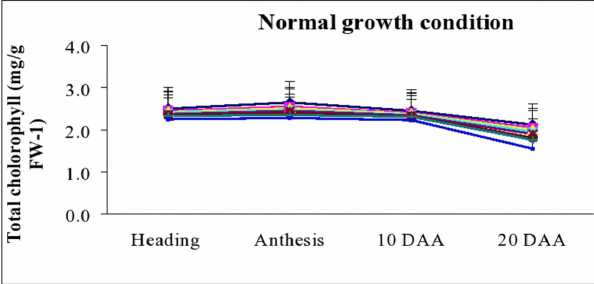
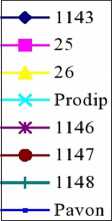
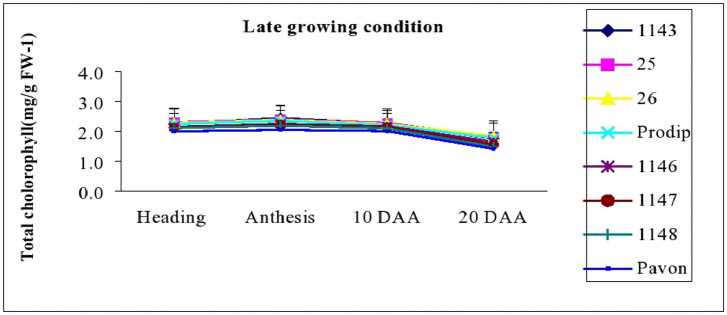
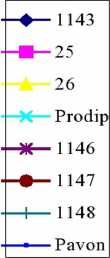
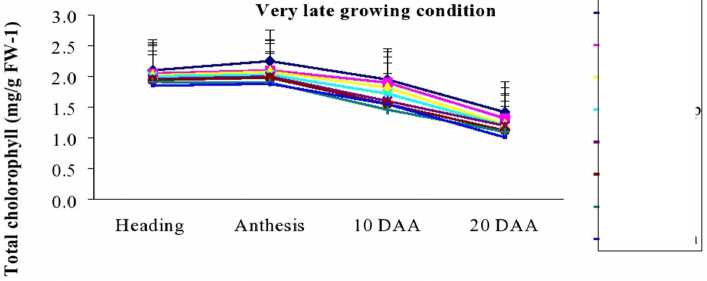
Figure 1.1. Effect of sowing conditions on total chlorophyll changes of eight wheat genotypes under normal, late and very late growing conditions in 2011/12.
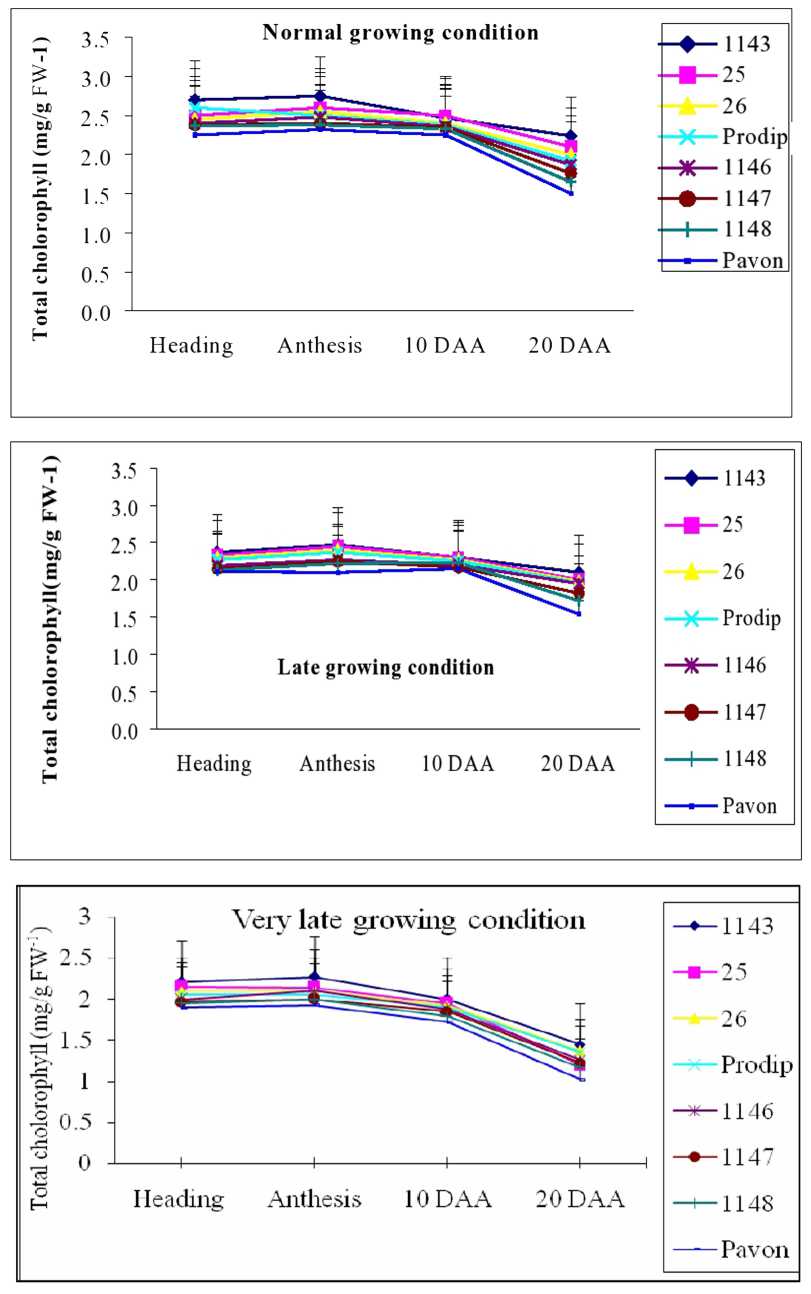
Figure 1.2. Effect of sowing conditions on total chlorophyll changes of eight wheat genotypes under normal, late and very late growing conditions in 2012/13.
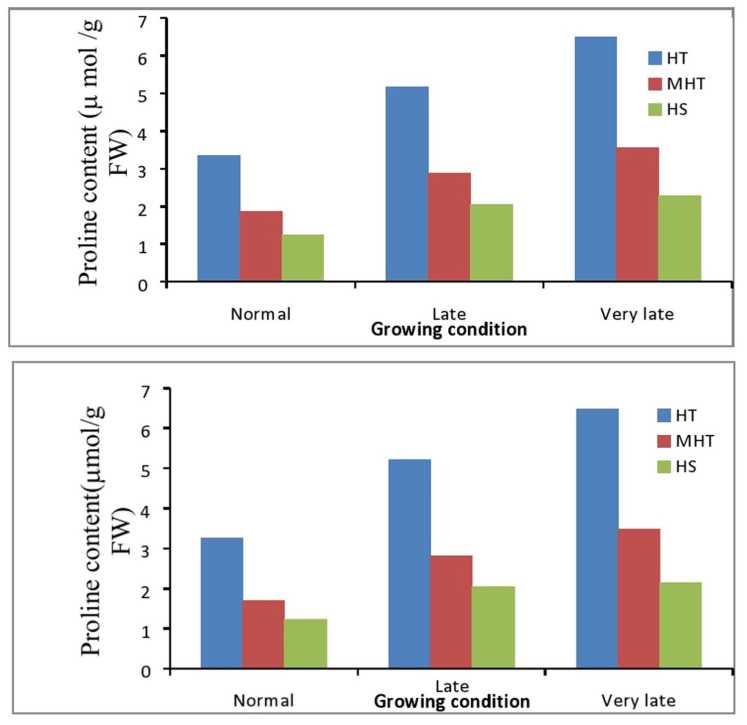
Figure 2. Average flag leaf proline content (µmol / g fresh weight) of heat tolerant and heat sensitive wheat genotypes as influenced by growing conditions in 2011/12 (upper graph) and 2012/13 (lower graph).
Table 1.1: Flag leaf proline content in eight wheat genotypes at 8 days after anthesis under normal late and very late growing conditions in 2011/12
|
Genotypes |
Flag leaf proline content (mmol /g fresh weight) |
|||
|
Growing condition |
Relative change (%) at very late growing condition compared to normal |
|||
|
Normal |
Late |
Very late |
||
|
Prodip |
2.36ijk |
4.73de |
5.25cd |
+122.46 |
|
BARI Gom-25 |
3.48fg |
4.78de |
5.60c |
+60.92 |
|
BARI Gom-26 |
3.65fg |
4.48e |
7.23b |
+98.08 |
|
BAW-1143 |
3.87f |
6.68b |
7.92a |
+104.65 |
|
BAW-1146 |
2.39ij |
3.56gh |
4.73de |
+97.91 |
|
BAW-1147 |
1.75klm |
2.57ij |
3.17gh |
+81.14 |
|
BAW-1148 |
1.47lm |
2.53ij |
2.75hi |
+87.07 |
|
Pavon-76 |
1.25m |
2.06jkl |
2.27ijk |
+81.6 |
|
CV (%) |
9.12 |
|||
Mean followed by same letter(s) did not differ significantly at 5% level of significance
Table 1.2: Flag leaf proline content in eight wheat genotypes at 8 days after anthesis under normal late and very late growing conditions in 2012/13
|
Genotypes |
Flag leaf proline content (m mole/g fresh weight) |
|||
|
Growing condition |
Relative change (%) at very late growing condition compared to normal |
|||
|
Normal |
Late |
Very late |
||
|
Prodip |
2.34ghi |
4.68d |
5.20cd |
+122.22 |
|
BARI Gom-25 |
3.32ef |
4.70d |
5.59c |
+68.37 |
|
BARI Gom-26 |
3.56e |
4.84cd |
7.21ab |
+102.53 |
|
BAW-1143 |
3.76e |
6.65b |
7.89a |
+109.84 |
|
BAW-1146 |
2.23hi |
3.46ef |
4.65d |
+108.52 |
|
BAW-1147 |
1.53ijk |
2.49gh |
3.12efg |
+103.92 |
|
BAW-1148 |
1.35jk |
2.45gh |
2.65fgh |
+96.30 |
|
Pavon-76 |
1.23k |
2.04hijk |
2.13hij |
+73.17 |
|
CV (%) |
6.53 |
|||
Mean followed by same letter(s) did not differ significantly at 5% level of significance
Table 2.1: Canopy temperature depression (ºC) of eight wheat genotypes as affected by growing conditions in 2011/12
|
Genotypes |
Canopy temperature depression (ºC) |
||
|
Normal growing condition |
Late growing condition |
Very late growing condition |
|
|
Prodip |
3.97g |
4.33ef |
5.22d |
|
BARI Gom-25 |
4.03fg |
4.35e |
5.25cd |
|
BARI Gom-26 |
4.37e |
4.53e |
5.55bc |
|
BAW-1143 |
5.21d |
5.63b |
6.12a |
|
BAW-1146 |
3.10ij |
4.23efg |
5.43bcd |
|
BAW-1147 |
3.32i |
4.52e |
5.65b |
|
BAW-1148 |
3.35i |
4.45e |
5.55bc |
|
Pavon-76 |
2.87j |
3.65h |
4.27efg |
|
CV (%) |
3.73 |
||
Mean followed by same letter(s) did not differ significantly at 5% level of significance
Table 2.2: Canopy temperature depression (ºC) of eight wheat genotypes as affected by growing conditions in 2012/13
|
Genotypes |
Canopy temperature depression (ºC) |
||
|
Normal growing condition |
Late growing condition |
Very late growing condition |
|
|
Prodip |
4.00fh |
4.32fg |
5.36bd |
|
BARI Gom-25 |
5.00de |
5.63bc |
5.67bc |
|
BARI Gom-26 |
5.50bd |
5.82b |
5.87b |
|
BAW-1143 |
5.50bd |
5.72b |
6. 83a |
|
BAW-1146 |
3.50hi |
4.13fg |
5.05ce |
|
BAW-1147 |
4.00fh |
4.39f |
5.47bd |
|
BAW-1148 |
4.50ef |
4.58ef |
5.63bc |
|
Pavon-76 |
3.00i |
3.75gh |
4.32fg |
|
CV (%) |
4.76 |
||
Mean followed by same letter(s) did not differ significantly at 5% level of significance
DISCUSSION
Results showed that chlorophyll content was decreased by high temperature in most of the genotypes. This result has an agreement with Ashraf and Bhatti (1998). They found that chlorophyll content was decreased in all wheat genotypes with delay in planting. The adverse effects of delayed sowing and wide variations were among genotypes for chlorophyll contents. Blum (1986) reported that total chlorophyll was lower in heat sensitive genotype compared to heat tolerant ones. Higher chlorophyll content and lower per cent decreased under stress have in tolerant genotypes of wheat. Heat stress reduces photosynthesis through disruption in the structure and function of chloroplast, and reduction in chlorophyll content (Xu et al. 1995). Chlorophyll content is positively correlated with the stability of the thylakoid membrane under heat stress, and can be used for screening for heat stress in wheat.
The increments of flag leaf proline content from normal to very late were significant for all wheat genotypes. Under supra-optimal temperature genotypic differences in proline accumulation pattern has also been reported in flag leaves of wheat (Hassan et al . 2007).
Plants usually accumulated some compatible solutes with low molecular mass such as proline (Tripathi et al. 2007). It has been shown that accumulation of proline is a common response to a wide range of biotic and abiotic stress such as high temperature (Kumar et al . 2012). The results of present research showed that increasing temperature lead to increase of proline content of plants. Those genotypes which had high proline content might increase ability to synthesize osmotic regulators for protection resulted from damage (Farshadfar et al . 2013).Heat shock increased proline and genotype response varied according to stress intensity (Hamli et al., 2015). Ahmed and Hasan (2011) mentioned that the increment of proline in different wheat genotypes were different and higher in heat sensitive genotypes. A positive correlation exits between the degree of proline accumulation and heat tolerance. Wheat genotypes having more accumulation of proline under heat stress have ability to bear heat stress. This phenomenon varies among the wheat genotypes because different genotypes have variable heat stress threshold. Hence, proline accumulation is a useful trait for selecting heat stress tolerant wheat genotypes.
These performances of different genotypes in CTD were reflected to their yield performance. Similar results were reported by Sikder and Paul (2010) and Reynolds et al. (1998), that potential to keep canopy cool is one of the important traits of high temperature tolerant wheat genotypes. This is reflected by canopy temperature depression which is expressed as difference between the ambient temperature and canopy temperature. High CTD has been used as a selection criterion to improve tolerance to drought and heat (Amani et al. 1996; Ayeneh et al. 2002).
Wheat genotypes exhibited genetic variability in canopy temperature depression among the wheat genotypes which was more conspicuous at heat stress and there was a significant correlation between grain yield and CTD. Numerous researchers also found cool canopy temperature with high grain yield (Bahar et al . 2011; Elbashier et al . 2012; Amani et al . 1996).
Increase in CTD might have occurred due to increase respiration and decreased transpiration resulting from stomatal closure (Siddique et al . 2000). The superior performance of genotypes with higher canopy depression like BAW-1143 under heat stress could be due to increase stay green duration and high chlorophyll content that enhanced photosynthetic activity.
CONCLUSION
The total chlorophyll content of flag leaf was slightly increased in all the genotypes from heading to anthesis. But after anthesis the chlorophyll content was found to be decreased and finally, reached to the lowest level at 20 DAA in each of the HT genotypes (BAW-1143, BARI Gom-25, BARI Gom-26 and Prodip), MHT genotypes (BAW-1146, BAW-1147, BAW-1148) and HS (Pavon-76) genotype for each growing condition of each year. Under late and very late growing condition, the flag leaf chlorophyll level was found to differ widely between the HT and HS genotypes from heading to senescence and in reduced form. Results showed that chlorophyll decreased at high temperature. Proline content in the flag leaf was significantly higher in HT genotypes e.g. BAW-1143, BARI Gom-26, BARI Gom-25 and Prodip than those of the heat sensitive genotype Pavon-76 and MHT genotypes BAW-1146, BAW-1147 and BAW-1148. In late and very late growing conditions, all the genotypes showed higher value compared to normal growing condition in different magnitude. Genotype BAW-1143 attained the highest value and whereas, the lowest in genotype Pavon-76. Under late and very late growing conditions, all the genotypes increased their CTD compared to normal growing condition in both the years but differ within the genotypes. At late and very late growing condition, HT genotypes BAW-1143 showed the highest canopy temperature depression and, BARI Gom-26 showed the highest CTD. Whereas, HS genotype Pavon-76 attained the lowest CTD in both the years.
Список литературы Impact of post-anthesis heat stress on physiological and biochemical traits of wheat genotypes
- Ahmed J. U. and Hasan M. A. (2011). Evaluation of proline content of genotypes in relation to heat tolerance. Bangladesh J. Bot. 40(1): 17-22
- Ashraf M. Y. and Bhatti A. S. (1998). Effect of delay sowing on some parameters of photosynthesis in wheat (Triticum aestivum L.). Wheat information service. 86: 46-48
- Barun H. J, Atlin G. and Payne T. (2010). Multilocation testing as a tool to identify plant response to global climate change. In: Climate change and crop production, Reynolds, C R P (Ed.). CABI, London, U K. pp. 34-78
- Blum A. (1986). The effect of heat stress on wheat leaf and ear photosynthesis. J. Exp. Bot. 37: 111-118
- Duncan D. B. (1955). Multiple range and multiple F-tests. Biometrics.11 (1): 1-42
- Elbashier E. M. E., Ttahir I. A S., Saad A. S I. and Ibrahim A. S. (2012). Wheat genotypic variability in utilizing nitrogen fertilizer for cooler canopy under a heat stressed environment. African J. Agri. Res. 7(3):385-392
- Farshadfar E., Poursiahbidi M.M., Safari S.M. and Vasough A.(2013). Screening of drought tolerance genotypes in bread wheat using a new integrated selection index. Adv. Crop Sci. 3: 237-246
- FAO (2014). FAO Statistical Year book 2014.World Food and Agriculture. Food and Agriculture Organization of the United Nations, Rome Italy. Pp. 34-56
- Farooq M., Bramley H., Palta J.A. and Siddique K.H.M. (2011). Heat stress in wheat during reproductive and grain-filling phases. Critical Review in Plant sciences.30: 1-17
- Hamli S.I., Labhilili M., Kadi K., Khabthan A.E.H., Alyadini M, Tagouti M., Manzali R., Gaboun. F and Bouzerzour H. (2015). Heat shock effects on chlorophyll luorescence, membrane stability and metabolites accumulation in durum wheat (Triticum turgidum L. var. durum) seedlings and relationship with yield stress tolerance indices. Adv. Environ. Biol. 9(8): 116-125
- Hasan M. A., Ahmed J. U., Bahadur M. M., Hoque M. M. and Sikder S. (2007). Effect of late planting heat stress on membrane thermostability, proline content and heat susceptibility index of different wheat cultivars. J. Natn. Sci. Found. Sri Lanka. 35(2): 109-117
- Kumar S., Gupta D. and Nayyar H. (2012). Comparative response of maize and rice genotypes to heat stress: status of oxidative stress and antioxidants. Acta Physiol. Plantar. 34: 75-86
- Reynolds M. P, Singh R. P., Ibrahim A., Ageeb O. A A., Larque-Saavedra A. and Quick J S. (1998). Evaluating physiological traits to complement empirical selection for wheat in warm environments. Euphytica. 100: 84-95
- Reynolds M. P., Hays D. and Chapman S. (2010). Breeding for adaptation to heat and drought stress.In: Climate change and crop production, C. R. P. Reynolds, (Ed), CABI, and London, UK. pp. 23-65
- Sikder S. and Paul N. K. (2010). Evaluation of heat tolerance of wheat cultivars through physiological approaches. Thai J. Agric. Sci. 43(4): 251-258
- Singh R. K. and Chaudhury B. D. (1985). Biometrical methods in quantitative genetic analysis (Revised Ed.). pp. 5-6. Kalyani publisher, Ludhiana, India
- Shewry P. R. (2009). Wheat. J. Exp. Bot. 60(6): 1537-1553
- Stone P. J. and Nicolas M. E. (1994). Wheat cultivars vary widely in their responses of grain yield and quality to short periods of post anthesis heat stress. Aust. J. Plant Physiol. 21: 887-900
- Tripathi S., Gurumurthi K., Panigrahi A. and Shaw B. (2007). Salinity induced changes in proline and betaine contents and synthesis in two aquatic macrophytes differing in salt tolerance. Biol. Planta. 51: 110-115
- Troll W. and Lindley J. (1955). A photometric method for determination of proline. J. Biol. Chem. 215: 655-660
- Witham F. W, Blydes D. F. and Devlin R. H. (1986). Exercises in plant physiology (2nd edition). pp. 128-131. PWS Publishers, Bonton, U.S. P
- Xu Q, Paulsen A. Q., Guikema. J A. and Paulsen G. M. (1995). Functional and ultrastructural injury to photosynthesis in wheat by high temperature during maturation. Environ.Exp. Bot. 35: 43-54

